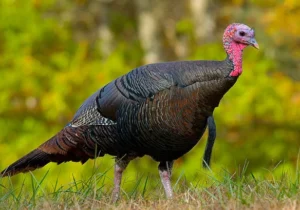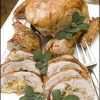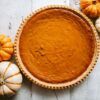Why Turkey?

Thanksgiving is by far one of America’s most celebrated holidays—the quintessential food holiday of the year. It’s the one holiday where even the most heathy of us throw out our diets and spend the day seeing who can unashamedly be the biggest glutton by gorging ourselves with stuffing, giblet gravy and cranberry sauce, potatoes, green bean casserole, Brussels sprouts, pumpkin pie . . . and of course, turkey.
But have you ever wondered why turkey?
Many Americans, when asked that question, refer to the “first Thanksgiving” and say that we are simply emulating the foods shared by the Pilgrims of the Plymouth colony and the local Wampanoag Indians during their three-day harvest feast in 1621. But the truth is, while wild turkey inhabited the area and was a favorite food of the local Native Americans, there is no direct evidence that turkey was part of that celebratory feast.
Probably the best accounting of that feast comes from Edward Winslow, author of Mourt’s Relation: A Journal of the Pilgrims at Plymouth. And while Winslow’s first-hand accounting of that day does speak of the Pilgrims gathering “wild fowl,” he makes no explicit mention of turkey being a part of that meal. Most historians seem to believe the reference to fowl was more likely that of ducks and geese. Winslow’s document also refers to the Wampanoag’s contribution of five deer to the feast, leaving us to conclude that roast venison was the major meat dish. Other foods served at this festive occasion likely included lobster, clams, fish, fruits and berries, corn, and squash.
Exactly when and how turkey came to be the centerpiece of our Thanksgiving table actually remains one of those many time-lost food mysteries. Some credit Sarah Joseph Hale, who was instrumental in getting Thanksgiving declared a national holiday, to bringing turkey into prominence with her extensive and graphic description of a New England Thanksgiving in the 1827 novel Northwood. Others say it was Charles Dickens’ 1843 novella A Christmas Carol that strengthened the idea of serving turkey as a holiday meal in which Scrooge, after repenting, sent the Cratchit family a prized turkey instead of the traditional English goose.Still others claim it was Alexander Hamilton’s love for the bird, declaring, “No citizen in the United States should refrain from turkey on Thanksgiving Day.”
There are also some practical reasons why colonial Americans choose turkey as their main Thanksgiving entree. The wild turkey was plentiful and free for the taking and large enough to feed a table full of people. The turkey has little utilitarian purpose compared to cows and to chicken, which also provide eggs. And they’re not so common as pork, making them a suitable choice for special occasions.
Throughout the 17th century a day of thanksgiving following the annual harvest continued to be a New England custom, although an official day for that celebration had not yet been established. Then in 1777, following the Patriot’s victory at Saratoga providing the turning point of the Revolutionary War, the Continental Congress proclaimed the first American thanksgiving.
George Washington, at the request of Congress, declared November 26, 1789 a “day of public thanksgiving and prayer.” But it was Abraham Lincoln who in 1863 proclaimed Thanksgiving a national annual holiday, although it took almost another forty years to become popular throughout America.
While Americans had come to observe Thanksgiving on the last Thursday of November, the day Lincoln made his historic proclamation, Lincoln never set an official date for its celebration. So in 1939, Franklin D. Roosevelt decided to correct this overlooked point and issued a proclamation making November 23 Thanksgiving Day, a decision that proved highly unpopular. In fact, many Americans refused to honor Roosevelt’s declaration. On November 26, 1941, Roosevelt bent to the will of the American people and signed a bill into law making the fourth Thursday in November as our official Thanksgiving Day.
Private citizens have gifted turkeys to our presidents for as long as it can be remembered. In fact Horace Vose, a Rhode Island turkey farmer, gave a turkey to the President every year from 1873 until his death in 1913. While many of the donated turkeys were of course eaten by the President and his family, many more were spared for various reasons—John F. Kennedy, Richard Nixon, and Jimmy Carter refused or returned their turkeys.
Ronald Regan started a new tradition when he was the first president to officially “pardon” his turkey, Charlie, a fifty pound Broad Breasted White turkey tom. Likewise, George H. Bush and every sitting president after him have ceremonially pardoned their turkey each year during the National Thanksgiving Turkey Presentation in the White House Rose Garden.
Wild turkeys, their population once considered endangered in the 20th century, today are once again in the millions and modern breeding has made domestic turkeys more affordable than ever. These facts ensure the turkey will continue to be the centerpiece of America’s Thanksgiving dinner table.
For those readers who want a taste of a presidential turkey I’ve included a recipe by René Verdon, White House Executive Chef hired by Jacqueline Kennedy in 1961. Verdon served both the JFK and LBJ administrations. I hope you'll try it.
Roast Turkey with Chestnut Stuffing
By René Verdon, White House Executive Chef
Allow for 3/4 to 1 pound per serving.
The Turkey
- Place stuffed Turkey on a rack in an open roasting pan, breast side up.
- Rub butter over the entire turkey. Season inside and out with salt and pepper to taste.
- Roast in a preheated oven at 350-degrees F. Baste once or twice with the drippings in the pan.
Roasting Times:
- 4 to 8-pound turkey: 3 to 4 hours
- 8 to 12-pound turkey: 4 to 4 1/2 hours
- 12 to 16-pound turkey: 4 1/2 to 5 hours
To test for doneness, move the leg joint up and down. It should give readily.
Chestnut Stuffing
Sufficient stuffing for a 12-pound turkey
Ingredients:
4 pounds chestnuts
4 teaspoons salad oil
6 cups beef broth
1 onion, chopped
2 tablespoons butter
½ pound sausage meat
1 teaspoon chopped parsley
½ tsp powdered thyme
salt and pepper to taste
¾ cup soft bread crumbs
½ cup cognac
Method:
- Cut a gash in the flat side of each chestnut. Heat the oil, add the chestnuts and cook over high heat for 3 minutes, shaking the pan constantly. Drain and cool. Remove the shells and inner skins.
- Cook the chestnuts in the broth until tender, about 20 minutes. Drain and reserve the broth for soup. Chop half the nuts coarsely and mash the rest.
- Cook the onion in butter until golden. Add sausage and seasonings and cook, stirring 4 to 5 mins. Add the chestnuts.
- Soften the bread crumbs in water. Squeeze out excess water and add to the chestnut mixture.
- Add cognac and mix thoroughly.
Thanks to the The White House Historical Association for supplying this recipe. The Association produces the Official White House ornament each year honoring presidents in sequential order as well as a number of books and a quarterly magazine each year related to White House history.






